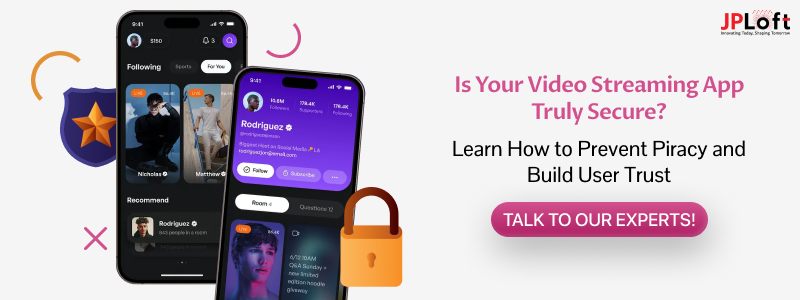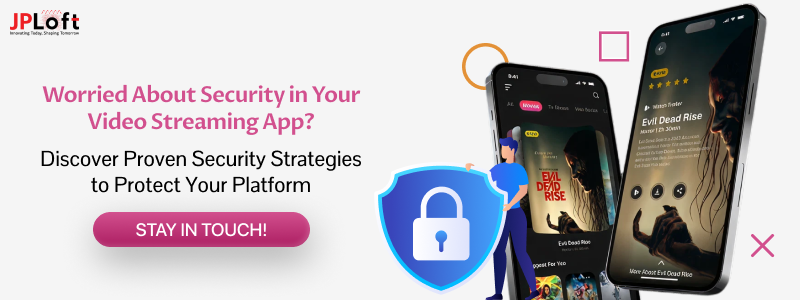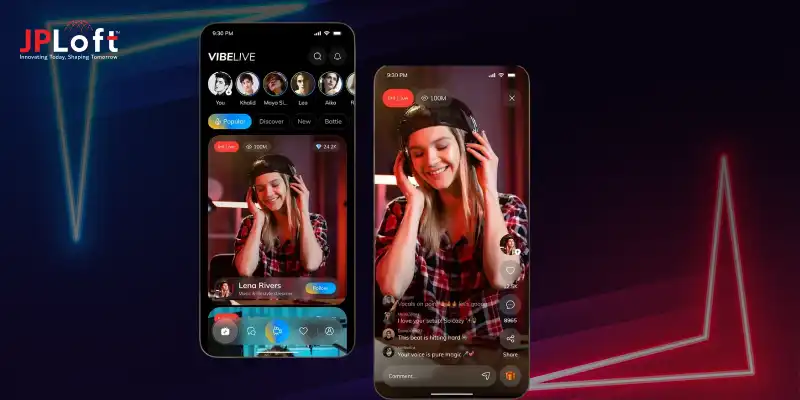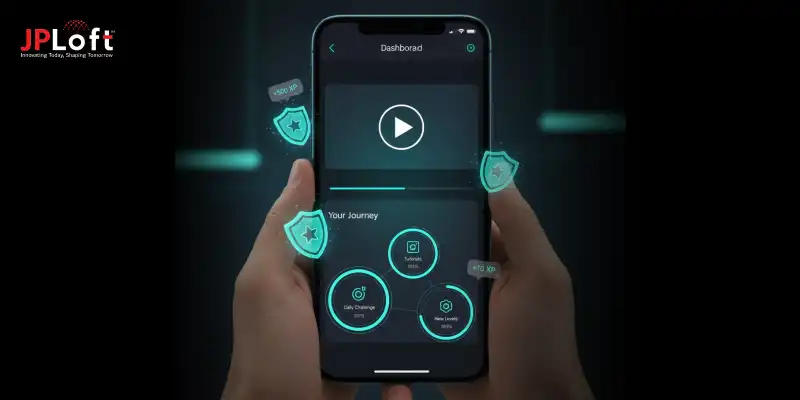Video streaming has become a go-to for entertainment, education, and even business. But with rising popularity comes rising risks like content theft, data breaches, and unauthorized access. That’s where video streaming app security best practices come into play.
Whether you're building an OTT platform or running a live-streaming app, securing your content and user data is non-negotiable. From encryption and DRM to secure APIs and user authentication, following the right steps can make all the difference.
In this blog, we’ll walk you through the video streaming app security that helps protect your platform, your content, and your audience, without compromising performance or user experience.
What is Secure Live Streaming? A Simplified Overview
Secure live streaming means delivering live video content to your viewers without compromising security or privacy. It’s all about protecting your content and your users from common risks.
Here’s a quick and easy breakdown:
-
Protects Content from Theft: Secure live streaming helps prevent video piracy by using encryption and digital rights management (DRM) to stop unauthorized copying or sharing.
-
Keeps User Data Safe: It ensures data privacy in video apps, safeguarding personal information like login details, payment info, and viewing history.
-
Uses Secure Tools: Platforms rely on secure video delivery tools such as HTTPS streaming, token authentication, and geo-blocking to control access and delivery.
-
Follows Legal Guidelines: To maintain trust and avoid penalties, secure streaming follows video streaming compliance standards like GDPR or DMCA.
-
Defends Against Online Threats: It protects platforms from video streaming app security threats like hacking, content leaks, and illegal redistribution.
In short, secure live streaming is a key part of video streaming app security best practices, helping you deliver content safely while keeping your platform and users protected.
Tech Backbone of Video Streaming Apps: 5 Essentials You Can’t Ignore
Building a modern video streaming platform goes far beyond just uploading and playing videos. To develop an app that’s scalable, secure, and user-friendly, you need the right mix of technologies working in sync behind the scenes.
Whether you’re planning to start an online video streaming app or upgrade an existing one, these five core technologies form the backbone of your app’s success.
Let’s explore the must-have tech components that not only boost performance but also align with the latest video streaming app security best practices.
A] Advanced Video Encoding & Transcoding
Before a video reaches a viewer’s screen, it needs to be compressed and converted into streamable formats.
This is where video encoding and transcoding technologies come into play.
By using codecs like H.264 or H.265 and implementing adaptive bitrate streaming (ABR), platforms ensure smooth video playback across different devices and internet speeds.
This not only improves the viewing experience but also helps in video encryption for streaming, which protects content during transmission and prevents unauthorized access.
B] Content Delivery Network (CDN)
A CDN is crucial to reduce latency and buffering. It distributes your video content across a network of global servers, ensuring users receive content from the nearest server location.
CDNs also support secure live streaming by accelerating encrypted content delivery and handling traffic spikes during high-demand events.
Integrating CDN with token-based authentication further helps prevent piracy in video streaming by controlling who can access specific content.
C] DRM & Secure Video APIs
Digital Rights Management (DRM) is a non-negotiable tool for content security. It limits how content can be accessed, copied, or shared especially vital for premium or paid video platforms.
Additionally, using secure video APIs ensures that every interaction with your app like logging in, purchasing a subscription, or viewing a video is controlled and authenticated.
This is central to app security for video platforms and forms a key part of the secure video streaming checklist.
D] Cloud Infrastructure with OTT Platform Security
Scalability and uptime are critical in video streaming. Cloud platforms like AWS or Google Cloud offer elastic server environments that automatically adjust to demand. However, without proper OTT platform security, your infrastructure may be vulnerable to attacks.
Implement encryption at rest and in transit, configure secure storage buckets, and apply role-based access controls to protect your app’s backend. These practices are essential for ensuring secure live streaming and safe user data handling.
E] Multi-Layered Authentication & Access Control
To strengthen app security for video platforms, implement multi-factor authentication (MFA), biometric logins, and role-based access. These features help restrict unauthorized access and prevent account sharing.
It’s a key part of any secure video streaming checklist and pairs well with video encryption for streaming to ensure only verified users can view premium content.
So if you’re planning to create an app in the streaming domain, keep this tech stack in mind to ensure performance, scalability, and strong security. This guide will help you align with the industry's video streaming app security best practices and deliver a robust user experience from day one.
Major Video Streaming App Security Risks to Watch Out For
With the ever-growing demand for digital entertainment, video streaming has become a primary mode of content delivery across the world. From OTT platforms and live events to subscription-based video services, platforms are under constant threat from hackers, pirates, and data breaches.
To build a truly reliable and trustworthy platform, it's crucial to understand and address the hidden dangers that can impact both user experience and business value. Following video streaming app security best practices is the key to safeguarding your app, content, and user data from the inside out.
Below, we break down the most common streaming security threats along with actionable strategies under “How to Overcome It” to help you maintain strong protection at every layer of your platform.
1. Piracy and Unauthorized Content Redistribution
Piracy is still one of the biggest development challenges of video streaming apps. Once your video content is made public, it can be illegally downloaded, screen-recorded, or re-uploaded without your permission.
This not only reduces your revenue but also undermines the confidence of your content partners and damages your brand’s credibility. Platforms that fail to prevent piracy in video streaming risk losing premium content deals and user trust.
How to Overcome It:
-
Use DRM in video streaming (Digital Rights Management) to control content usage rights and block unauthorized downloads.
-
Apply video encryption standards like AES-128 and HLS encryption to secure content delivery.
-
Conduct regular audits and apply strong app encryption techniques to limit tampering.
-
If you're looking to monetize a video streaming app, this layer of protection is critical for sustaining long-term revenue.
2. API Vulnerabilities and Poor Access Control
Streaming platforms rely heavily on APIs to authenticate users, deliver videos, manage subscriptions, and collect analytics. However, without strong API security in video streaming, these APIs become a doorway for hackers to manipulate data, bypass paywalls, or hijack user sessions.
How to Overcome It:
-
Secure APIs using token-based authentication, rate limiting, and IP whitelisting.
-
Use secure video APIs that support encryption and end-to-end user validation.
-
Apply access control with role-based permissions.
-
Choose frameworks aligned with secure video app development practices to reduce backend risks.
3. Insecure OTT Infrastructure
Many platforms are hosted on third-party cloud services and OTT frameworks. If your storage or server environment lacks proper configuration, attackers can gain access to your video libraries, source code, or subscriber data.
This is especially risky when platforms overlook OTT platform security protocols or ignore regular app maintenance service.
How to Overcome It:
-
Regularly audit all third-party plugins, APIs, and cloud configurations.
-
Enable cloud security for streaming by encrypting stored files and restricting access with proper credentials.
-
Implement web application firewalls (WAF), anti-DDoS systems, and secure load balancers to filter malicious traffic.
-
Monitor your cloud environment in real-time and set up alerts for unusual activity to quickly identify and respond to potential breaches.
4. Weak App-Level Protection
A well-built backend won’t save you if your app itself is exposed. Many streaming apps can be reverse-engineered to disable features, block ads, or access premium content without paying. These vulnerabilities usually stem from neglecting core mobile app security measures.
How to Overcome It:
-
Obfuscate source code and apply certificate pinning.
-
Use streaming app security tips like two-factor authentication, session timeouts, and device-level security.
-
Integrate SDKs that support secure streaming with built-in threat detection features.
-
Use biometric logins to improve both convenience and protection.
5. Data Breaches and Privacy Violations
User data like personal info, payment details, and viewing history is sensitive and highly valuable. A single breach can result in legal penalties and erode user trust permanently. Ensuring video content security isn’t just about protecting your videos, it’s also about protecting your users.
How to Overcome It:
-
Encrypt all data at rest and in transit using trusted app encryption techniques.
-
Ensure your platform complies with video streaming compliance regulations such as GDPR or CCPA.
-
Use tokenized payment gateways to protect sensitive billing data.
-
For platforms handling high-volume traffic, choosing the right video streaming app tech stack plays a big role in managing data securely and efficiently.
6. Live Streaming Hijacking
Live broadcasts often draw large audiences and opportunistic hackers. Without secure live streaming mechanisms, your stream can be intercepted, pirated, or even replaced in real time, disrupting the viewer experience.
How to Overcome It:
-
Use protocols like RTMPS and SRT to secure live content delivery.
-
Implement IP-based and geo-restriction access to control who can view the stream.
-
Add session tokens and expiration rules to prevent unauthorized playback.
-
Embed watermarking and DRM for live content, just as you would for on-demand videos.
7. Lack of Encryption and DRM from the Start
Some platforms make the mistake of launching without a security-first mindset. Skipping video encryption or not applying DRM early leaves your content exposed and hard to protect later on.
This makes platforms especially vulnerable during scaling and expansion.
How to Overcome It:
-
Integrate security into your design process through secure video app development practices.
-
Make security a continuous focus throughout your streaming app development lifecycle.
-
Conduct regular vulnerability scans and penetration tests to detect weak points.
-
Align your growth plan with the cost to build a video streaming app that includes security budgeting from day one.
Every streaming platform, whether you're building the next big OTT app or simply offering niche content, must treat security as a core function, not an add-on.
From DRM in video streaming to cloud security for streaming, applying the right protection strategies ensures your app remains trustworthy and competitive.
After all, the best video streaming apps don’t just stream smoothly, they keep both content and viewers safe.
Checklist: 10 Best Practices to Ensure Secure Video Streaming
When you're constructing a safe video platform, doing the right things initially can keep you from suffering expensive damage down the line.
With cyber attacks and piracy evolving to become more sophisticated, adherence to tested video streaming app security best practices is a must.
Here's a comprehensive checklist of the top 10 best practices to assist you in protecting your video content, platform, and users effectively:
1. Utilize DRM (Digital Rights Management)
One of the first lines of defense is DRM in video streaming. It ensures that your videos can't be copied, downloaded, or shared without permission.
DRM restricts how users consume your content, such as viewing limits, offline access control, and device restrictions.
Whether you’re running a subscription model or pay-per-view, DRM is a must for preventing misuse.
2. Apply Strong Video Encryption
Encryption secures video content as it moves between the viewer and the server.
Employ advanced video encryption technologies such as AES-128 and HLS encryption to encrypt the video stream so that even when it's intercepted, it's worthless without the correct decryption key.
You can hire dedicated developers to ensure that these encryption methods are properly integrated into your app’s architecture for maximum protection.
3. Lock Down Your APIs
APIs govern essential operations such as login, video playback, and subscription access. Loose API designs invite hackers. API security in video streaming is, therefore, paramount.
Employ token-based authentication, access control, rate limiting, and always validate incoming data to prevent abuse or data leaks.
4. Use Secure Streaming Protocols
Live streams are particularly at risk of hijacking and unauthorized retransmission.
For safe streaming, employ encrypted protocols such as RTMPS (Real-Time Messaging Protocol Secure) or SRT (Secure Reliable Transport).
These block interception and enable smoother, more secure real-time content delivery.
In fact, adopting encrypted live protocols is one of the top trends of video streaming apps as platforms prioritize both speed and security in real-time broadcasts.
5. Enhance App-Level Security
Even the greatest backend will be useless if your app is not up to par. Put in place fundamental app security measures such as code obfuscation, certificate pinning, and activation of two-factor authentication.
Accompany this with app encryption techniques to protect confidential user data and thwart reverse engineering or tampering.
6. Utilize Secure Video APIs and SDKs
Use only those secure video APIs and SDKs with end-to-end encryption, access control, and session-based management. This will keep your app secure while minimizing the drudgery of coding custom security logic.
7. Secure Your Cloud and OTT Infrastructure
Most online video platforms now exist in the cloud or OTT environments. Yet, misconfigured storage or obsolete integrations can cause security issues. Prioritize cloud security for streaming.
Encrypt storage buckets, enforce access restrictions, and apply role-based user controls. Don't neglect OTT platform security, particularly if utilizing third-party content management or delivery infrastructure.
8. Leverage AI for Proactive Threat Detection
Artificial Intelligence is playing an increasingly important role in secure video app development.
AI-powered security tools can monitor streaming behavior in real time to detect anomalies such as credential stuffing, piracy attempts, or unusual access patterns.
If you're looking to add smart protection, it's worth exploring how to build an AI app that can analyze user behavior, automate threat detection, and enhance security workflows.
AI can also help protect streaming content more proactively, automatically flagging risks faster than traditional systems.
9. Remain Compliant and Privacy-Conscious
Security is also safeguarding your users. Make video streaming compliant with international privacy regulations such as GDPR, CCPA, and so on.
Protect payment information, restrict user tracking, and save personal data securely.
When users feel their information is secure, they are more likely to trust and be loyal to your application.
10. Embed Security into the Development Lifecycle
Don't wait until launch to consider security.
Right from day one, use secure video app development best practices, such as coding securely, using current libraries, and conducting regular security audits. Integrate security in video streaming app development to make your app future-proof.
This also assists in addressing the video streaming app development issues prior to their escalation. And, it keeps you on top of the leading trends where security is a leading competitive aspect.
By taking these best practices, you are not only securing your content but also setting the foundation for long-term growth, reputation, and revenue. Whether a startup or scaling business, this checklist can be a helpful guide toward a secure and successful platform.
Next-Gen Protection: Why AI, ML & NLP Are Essential for Video Streaming App Security
As video streaming platforms face more complex security threats, traditional measures are no longer enough. That’s where next-gen technologies like Artificial Intelligence (AI), Machine Learning (ML), and Natural Language Processing (NLP) step in to revolutionize how platforms detect, respond to, and prevent cyber risks.
-
By integrating advanced AI development services, streaming apps can monitor unusual activity in real time, such as login anomalies or suspicious viewing behavior and respond instantly. This proactive approach helps stop threats before they escalate.
-
Meanwhile, ML development services enable platforms to learn from past attack patterns and adapt security protocols automatically. Over time, this makes your platform smarter and more resilient without manual intervention.
-
NLP development services add another layer by analyzing user-generated content (like comments, messages, or search queries) to detect abuse, phishing attempts, or sensitive data leaks especially on community-driven streaming platforms.
Together, AI, ML, and NLP form an intelligent defense system that strengthens your app’s security backbone.
For developers aiming to stay ahead of modern threats, combining these technologies with traditional security protocols is quickly becoming one of the most effective video streaming app security best practices.
Video Streaming App Compliance & Privacy Best Practices
When it comes to building trust and maintaining legal integrity, streaming apps must take privacy and compliance seriously. Here’s how to address both effectively:
-
Prevent piracy in video streaming by using advanced content protection tools like DRM (Digital Rights Management), watermarking, and token-based authentication.
-
These measures help you protect streaming content from unauthorized downloads, screen recording, and illegal redistribution.
-
Users share personal data such as login credentials, payment details, and viewing history, making data privacy in video apps a top priority.
-
Comply with global data privacy laws like GDPR, CCPA, and India’s DPDPA by collecting user consent, providing opt-out options, and clearly stating privacy policies.
-
Use role-based access controls to limit who can see or change user data or system settings.
-
Keep your systems updated with regular app maintenance, mobile app testing etc. to identify vulnerabilities before they can be exploited.
By following these strategies, your app not only stays compliant with regulations but also earns user trust, turning privacy and protection into key brand strengths.
Build a Secure, Scalable Video Streaming App with JPLoft
Looking to build a video streaming platform that is fast, secure, and ready to scale? JPLoft can help you bring that vision to life.
As a trusted video streaming app development company, we specialize in creating custom solutions tailored to your needs, whether you're launching an OTT platform, a live-streaming service, or a premium content app.
From secure APIs and video encryption to DRM implementation and performance optimization, we ensure your app is protected and future-ready. With us, you don’t just get a development team, you get a technology partner that’s invested in your success.
Let’s turn your streaming idea into a high-performing, secure reality.
Final Wrap-Up
When it comes to protecting your platform, users, and content, applying the right video streaming app security best practices is a must.
Whether you're running live events or building an OTT app, addressing security threats like piracy, data breaches, and API abuse is essential for long-term growth.
With the right tech stack and a reliable development partner, you can build a platform that’s not only secure but also scalable, user-friendly, and ready to monetize.
Now’s the time to level up your video streaming journey, securely and smartly.
FAQs
Because it protects your content from piracy, ensures user privacy, and keeps your app compliant with regulations. Without security, both revenue and trust are at risk.
DRM (Digital Rights Management) restricts unauthorized copying, downloading, and sharing of video content, making it harder for pirates to misuse your media.
Use DRM, video encryption, watermarking, and token-based access to secure your content. Also, audit your platform regularly for vulnerabilities.
Secure APIs help manage authentication, user permissions, and content delivery. They block unauthorized access and prevent data manipulation.
To ensure secure live streaming, use encrypted protocols like RTMPS or SRT, apply geo-blocking and IP restrictions, implement DRM, and enable session-based access control.













Share this blog